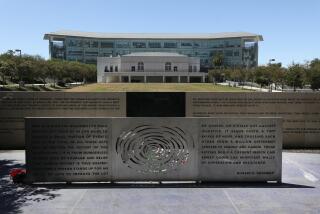Parents Raising Money to Stock Schools With Quake Supplies
- Share via
Caught between a money-short school district and fears for their children’s lives, San Fernando Valley parents have been forced to pay for bandages, water and other earthquake survival supplies in the last few years.
“I thought--living in the state of California where there are earthquakes--that our schools would be protected,” said parent Candy Stanman, chairwoman of the earthquake preparedness committee at Millikan Junior High in Sherman Oaks. “I’m very angry about the whole situation. I think the schools are responsible. That’s their job, to protect the children and the schools.”
The Los Angeles Unified School District expects parents to share the cost of preparedness, but PTA leaders face a host of problems in giving students the best chance of surviving an earthquake: parent apathy, district rules and a lack of action by administrators.
Millikan recently raised about $1,000 for survival supplies from a spaghetti dinner. Other schools have been selling cupcakes, holding book fairs, redeeming recyclable cans and asking for help from local businesses to outfit each classroom with survival goods.
Parents want thermal blankets, food, water, flashlights, hard hats, stretchers and crowbars to prepare for a quake that scientists say could devastate the Los Angeles area.
The school district considers those items essential, but the profusion of educational programs competing for funding has dampened parents’ hopes for disaster preparedness.
Jerry Kurilich, director of the school district’s emergency services office, said it was unrealistic to expect a district facing a $200-million deficit to fund supplies single-handedly.
“We know what we have to do but we don’t have the money to do it,” he said. “The district looks at this as a joint school and parent effort.”
But some parents say that if the district rated preparedness a high priority, it would find the funding.
“Everybody says, ‘Gee, this is important but we don’t have the money for it.’ It’s quite sad because it’s little children that are going to be victims,” said Rheva Nickols, PTA safety chairwoman at Kester Avenue Elementary School. At the school, $2,000 trickled in over three years to buy 10 55-gallon water barrels and other emergency supplies for each classroom.
Despite the poor funding, some headway has been made.
The school district has equipped each of its 600-plus schools with two hand-held radios and first aid kits with enough supplies to care for 100 injured people for three days. In the last five years, the district has trained 4,000 school personnel in first aid, held search-and-rescue classes and created school drill plans that are mandated by law.
The district has been considering training its 57,000 employees on rescue techniques and assigning priorities for medical treatment. And it may revoke a rule requiring district approval before schools can hold fund-raisers, take in money and accept supplies donated for earthquake preparedness.
The Valley’s 31st PTA District, which used to prohibit its chapters from spending more than $250 a year for earthquake preparedness because unlimited spending was considered unfair to schools that didn’t have similar resources, now advises its 153 Valley schools to work on preparedness.
Diana Dixon-Davis, disaster preparedness chairwoman for the 31st District, said she plans to ask the district to create guidelines on preparedness, fund a permanent emergency services coordinator and provide basic supplies, such as water, for all schools.
Since she raised funds for supplies for her children’s school seven years ago, Dixon-Davis has seen the number of PTAs doing the same thing double. She said about 30 schools supplement what the district gave them.
“They’re getting scared. Look at all the earthquakes” that have occurred around us, Dixon-Davis said. But she fears the district may tell PTAs: “You do it all.”
Other school districts also expect parents to chip in for supplies, but some have bought equipment and cargo-type containers to hold it, along with adhesive window film that would stop breaking glass from falling into classrooms.
PTA leaders said poor parent participation has hampered their efforts, leaving them feeling isolated in their mission.
“I realized right off the bat when we tried to get donations from parents for the buckets that it was going to be a long haul,” Nickols said. “They want something done for earthquake preparation for their schools, but they don’t want to put a lot of effort into it. It’s fear, too. They don’t want to think about it. “
Nickols was one of five parents with children at Kester who asked the board of education in 1988 to decrease the number of non-structural hazards, such as windows, that could shatter during an earthquake.
The district will not allow windows to be coated with a polyester retention film, even if parents raise the money to pay for it. In past earthquakes, glass from school windows has flown across classrooms. No one was injured because the quakes occurred while school was not in session.
Kurilich said the district would be liable if parents bought the coating and were injured while applying it to the windows. But he said he also recognized that the district might be responsible for injuries that result from broken windows.
Parents aren’t waiting for the district to change its rules. Stanman, struggling to gather $2,000 more for supplies, may have to raise money again when her 13-year-old son moves on to high school.
“I don’t know that the school will be really equipped to my satisfaction by the time my child graduates,” Stanman said. “We’ll have a lot more expenses if our children are injured and if parents decide to sue the school system for not taking action.”
More to Read
Sign up for Essential California
The most important California stories and recommendations in your inbox every morning.
You may occasionally receive promotional content from the Los Angeles Times.










